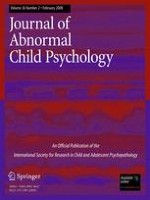01-02-2008
Parent–Child Relationships and ADHD Symptoms: A Longitudinal Analysis
Gepubliceerd in: Research on Child and Adolescent Psychopathology | Uitgave 2/2008
Log in om toegang te krijgenAbstract
Evidence both from psychological research and clinical intervention studies suggests that there are bidirectional influences between overt child behavior problems and parent–child relations. Very little research however, has considered the pattern of relations that exists between Attention Deficit Hyperactivity Disorder (ADHD) and the parent–child relationship within a longitudinal context. Using a longitudinal community sample from the United Kingdom which included 194 school aged children (46% male and 54% female) and both parents, this study examined the relationship between child ADHD symptoms and displays of rejection in the parent–child relationship. These relationships were investigated separately for mothers and fathers using cross-lagged panel correlation and reciprocal effects analysis. Mothers and fathers reported on ADHD symptoms and children reported on their feelings of rejection in the mother–child and father–child relationships. Results suggested differences in the direction of effects linking mother– and father–child rejection and child ADHD symptoms; with ADHD symptoms affecting the mother–child relationship and the converse pattern of effects noted for fathers. Implications for future research focusing on the link between ADHD symptoms and parent–child relationships are discussed.
